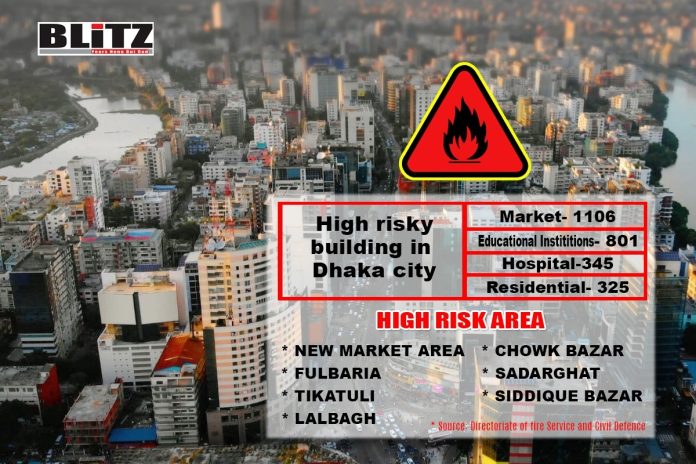In the heart of Dhaka, where the rhythmic chaos of daily life unfolds, lies a cityscape teeming with vitality and opportunity. Yet, amidst the hustle and bustle, a silent menace lurks, threatening to engulf the fabric of urban life in flames. The specter of fire hazards looms large over Dhaka, casting a shadow of uncertainty over its bustling markets, commercial establishments, and residential neighborhoods.
At the forefront of this impending crisis stand structures like Gauchia Market and Dhaka New Super Market in Dhanmondi, emblematic of both commerce and community, now marred by the looming threat of fire hazards. Gauchia Market, a bustling hub catering to women shoppers, embodies a paradox-a vibrant center of activity overshadowed by the looming specter of vulnerability. Despite repeated warnings issued by the Fire Service and Civil Defense Directorate dating back to 2019, scant action has been taken to rectify the glaring deficiencies in fire safety protocols. The tragic inferno that engulfed Dhaka New Super Market in April of the preceding year stands as a stark reminder of the pressing need for intervention. Regrettably, the lessons gleaned from this catastrophe appear to have been disregarded, perpetuating a cycle of inaction and complacency.
The perilous predicament facing Gauchia Market is underscored by the myriad challenges it presents in the event of a fire outbreak. With inadequate access to water sources, obstructed escape routes, and rampant electrical hazards, the potential for catastrophe looms large. The labyrinthine layout of the market, with merchandise spilling onto narrow passageways and makeshift shops erected precariously on staircases, paints a sobering picture of an accident waiting to happen. Despite the clear and present danger, the response from market authorities has been lukewarm at best, with past and present presidents of shop owner associations evading accountability and neglecting their duty to ensure public safety.
The alarming prevalence of fire hazards extends far beyond Gauchia Market, with a staggering 2,603 buildings in Dhaka flagged as potential tinderboxes awaiting ignition. These structures, ranging from commercial enterprises to educational institutions, hospitals, residential complexes, and media outlets, represent a microcosm of the city’s vulnerability to catastrophic events. While the Fire Service has conducted sporadic inspections in an attempt to assess and mitigate the risks, the sheer magnitude of the task renders it virtually impossible to comprehensively identify and address every potential hazard. This systemic failure in oversight and regulation underscores the urgent need for a paradigm shift in the approach to fire safety management.
Despite legislative safeguards like the Fire Prevention and Extinguishing Act of 2003, which mandates stringent fire safety clearances for multi-storied buildings, compliance remains abysmally low. Many building owners, driven by profit motives and short-term gains, neglect to renew fire licenses or implement safety protocols post-construction, leaving tenants and occupants vulnerable to the whims of fate. The Fire Service, constrained by bureaucratic red tape and limited resources, finds itself hamstrung in its efforts to enforce compliance and ensure adherence to safety standards. The issuance of warnings and appeals for remedial action, while well-intentioned, often fall on deaf ears, further exacerbating the precarious state of affairs.
Tragic incidents like the recent fire at Green Cozy Cottages on Bailey Road, claiming the lives of 46 individuals, serve as sobering reminders of the human cost of negligence and complacency. Yet, in the aftermath of each disaster, the cycle of inaction and indifference persists, perpetuating a vicious cycle of preventable tragedies. Muktar Hossain, who lost loved ones in the Bailey Road inferno, speaks for many when he implores authorities to prioritize human life above all else, urging swift and decisive action to mitigate the looming threat of fire hazards.
The urgency of the situation is further underscored by the glaring lapses in oversight and accountability exhibited by building authorities and regulatory bodies. Instances like the recent fire at a 21-storey building in Shyamli, where fire safety deficiencies remain unaddressed despite repeated warnings, highlight the systemic failures that plague the city’s urban landscape. Without meaningful reforms and concerted efforts to address these deficiencies, the specter of fire hazards will continue to cast a pall over Dhaka’s future, endangering the lives and livelihoods of its residents.
In the face of escalating risks, it is imperative for stakeholders to adopt a proactive and collaborative approach to fire safety management. This entails not only strict enforcement of existing regulations but also concerted efforts to raise public awareness, foster community engagement, and invest in robust fire prevention infrastructure. Building owners, authorities, and regulatory bodies must work hand in hand to ensure compliance with safety standards, implement effective risk mitigation strategies, and prioritize the safety and well-being of all residents.
As Dhaka confronts the looming threat of fire hazards, the imperative for action is urgent. Ignoring the warning signs and neglecting to address the underlying causes of the crisis could result in devastating consequences, endangering innocent lives and undermining the very essence of the city’s social cohesion. In our pursuit of advancement and growth, it is paramount that we remain steadfast in our commitment to safeguarding human life and fostering a community resilient to such perils. Let us not falter in our responsibility to protect and uphold the safety of all residents, paving the way for a future that is both secure and prosperous for generations to come.




